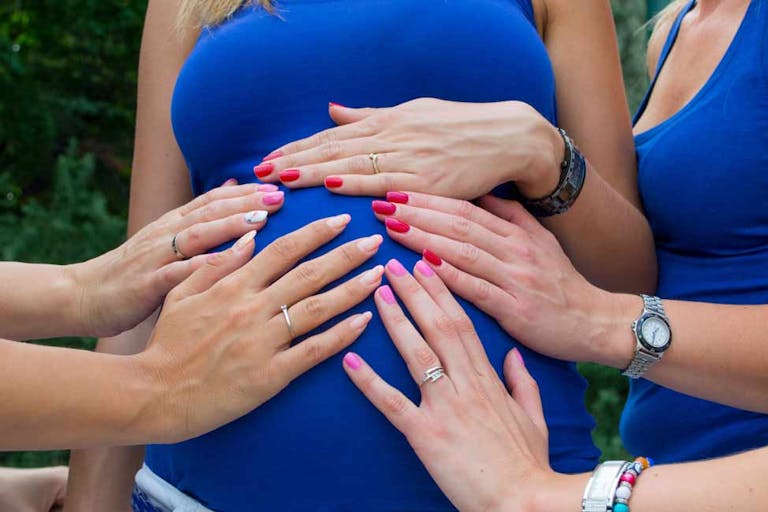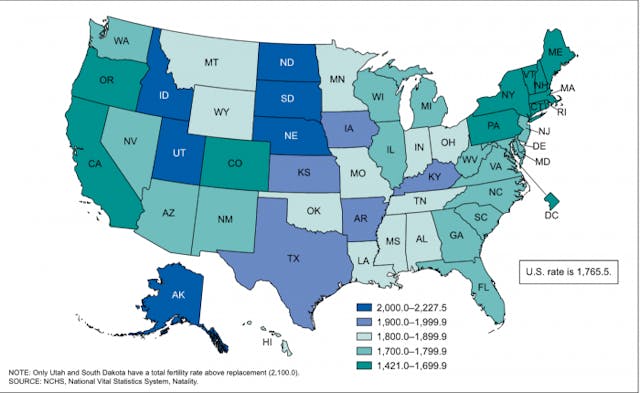
Korean scholars caution that assisted suicide, abortion laws risk undermining ethical foundations
Angeline Tan
·
Issues·By Catherine Livingston, PhD
Fertility rate of U.S. women plummets to lowest level in 30 years
The United States fertility rate has hit its lowest in three decades, according to a National Vital Statistics Report (NVSS) released Thursday from the CDC. The results show a significant variance between states’ fertility rates, but the numbers are troubling. The report notes that the total fertility rate (TFR) is “16% below what is considered the level for a population to replace itself…. For overall population, only two states, South Dakota and Utah, had TFRs above replacement level.”
This means, of course, that if the current pace continues, the nation will continue to decline in population, theoretically, until there are no more young people to reproduce.

Total Fertility Rates by State and Race and Hispanic Origin: United States, 2017
Some of the states with the lowest fertility rates also appear to have the highest abortion rates, while some of the states with the lowest abortion rates have some of the highest fertility rates. According the CDC’s most recently available Abortion Surveillance Report from 2015, the pro-life state of South Dakota, which, along with Utah is only one of two states with a high enough fertility rate to sustain its population, had 444 abortions; it had a population of about 860,000 that year.
By contrast, the District of Columbia, which had the lowest fertility rates currently reported, has a reputation for late-term abortions. Despite having a 2015 population of about 672,000, the CDC reported 1,267 abortions — three times the number in South Dakota, which has 200,000 more people. While the numbers vary from state to state, and abortion rates can’t be attributed to every instance of declining birth rate, abortion rates certainly can’t be ignored.
Live Action News reported last September how abortion was contributing to declining birth rates in various nations of the world, including the United States, as well as Japan and China, pointing out:
Sadly, the U.S. abortion rate even made the top ten in the world, as reported by the United Nations in 2013…
Article continues below
Dear Reader,
In 2026, Live Action is heading straight where the battle is fiercest: college campuses.
We have a bold initiative to establish 100 Live Action campus chapters within the next year, and your partnership will make it a success!
Your support today will help train and equip young leaders, bring Live Action’s educational content into academic environments, host on-campus events and debates, and empower students to challenge the pro-abortion status quo with truth and compassion.
Invest in pro-life grassroots outreach and cultural formation with your TRIPLED year-end gift!
With a fertility rate of only 1.6, China’s population will drop 28 percent by 2100, ceding the title of world’s most-populous nation to India, the UN predicts. With a fertility rate of 1.4, Japan’s population will plunge 34 percent by 2100. The U.S.’s headcount is expected to keep growing, despite a low fertility rate of 1.8, because of large numbers of immigrants, though government policies could change that.
Other news reports share opinions from experts attributing the fertility decline to economic reasons. ABC News reports on Dr. Karen Guzzo, associate director of the Center for Family & Demographic Research at Bowling Green State University:
“[W]e kind of expected that after the Great Recession has supposedly disappeared and we are doing much better, fertility rates would start to pick up…. They really haven’t recovered as much as we had expected, and I think that suggests a lot about how people feel in terms of their own personal lives and how secure they feel. It’s not just the global or national economic or GDP numbers, it’s, ‘Can I pay my bills, can I pay my student loans, can I buy a house, is my job secure? Do I have a strong relationship and can I maintain that?’ So people go through a lot of uncertainty,” she said. “I really think that those characteristics haven’t improved as much over the last 10 years, and that’s probably what’s going on here.”
However, Guzzo’s words are similar in topic to the words abortion advocates use when they tell women they don’t need to have children until they are ready, that careers should come first, that money and financial security are the most important things. Women have been led to believe they must have it all — and in a certain order — for so long that it may be factoring into their decision to delay childbirth, whether by abortion or birth control. And now the consequences are showing themselves.
As Live Action News previously noted, other nations with declining fertility have partially solved the problem with increasing immigration:
The message is that ongoing high immigration, coupled with a recent increase in the birth rate, could keep the country’s population stable for another forty years… In 2015, Germany recorded net migration of more than one million people as a result of the arrival of refugees from Syria, Iraq and Afghanistan. In 2016, that figure was 750,000 people.
Additionally, Bloomberg reports that in Germany, the fertility rate is up “thanks in part to a recent immigration surge but also to adoption of family-friendly policies, including raising parental-leave allowances.” With American immigration at its most controversial in decades, with its fertility rate hovering there as well, it’s clear it’s a season of decision for the nation. Deciding to not have children over and over is resulting in some dire consequences.
Live Action News is pro-life news and commentary from a pro-life perspective.
Contact editor@liveaction.org for questions, corrections, or if you are seeking permission to reprint any Live Action News content.
Guest Articles: To submit a guest article to Live Action News, email editor@liveaction.org with an attached Word document of 800-1000 words. Please also attach any photos relevant to your submission if applicable. If your submission is accepted for publication, you will be notified within three weeks. Guest articles are not compensated (see our Open License Agreement). Thank you for your interest in Live Action News!

Angeline Tan
·
Issues
Angeline Tan
·
Issues
Nancy Flanders
·
Issues
Wesley J. Smith
·
Issues
Michael J. New
·
Issues
Right to Life UK
·
Human Interest
Catherine Livingston, PhD
·
International
Catherine Livingston, PhD
·
Newsbreak
Catherine Livingston, PhD
·
Human Interest
Catherine Livingston, PhD
·
Human Interest
Catherine Livingston, PhD
·